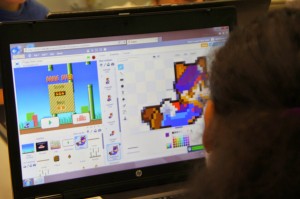
He called himself MechaStayPuft. That was the username and avatar he would use across all of the game design platforms we used. It struck me as an odd choice for a teenager, a compound reference to Ghostbusters, which turned 30 this past June, and Gozilla vs. MechaGodzilla, which predates Ghostbusters by a decade. How did a student who couldn’t have been born before the Clinton administration be acquainted with two relics of 70s and 80s counterculture?
Regrettably, I never found out. MSP wouldn’t make it past class 5. And he wasn’t the only deserter, either. By the seventh and last class one week ago, only two students had stuck it out all the way. This seemed unreasonable for a free course on custom designing video games. What did I (the instructor) do wrong?
The truth is, these disappointing attendance figures weren’t directly my fault. Teenagers today may watch more television and consume more media than ever, but they also go to summer camp and join their families for extended vacations. And since the class was hosted by the New York Public Library (and co-sponsored by MOUSE), no commitment was required and students could come and go as they pleased.
My hope was that the subject matter would be interesting enough to capture their attention, making them want to come back every week. But here’s what I learned, that proved the contrary:
- Making games is hard. Despite the ample tools that make it possible (we were using two fantastic ones, E-Line Media’s Gamestar Mechanic and MIT’s Scratch), the individual virtues of patience and curiosity are rare and harder to teach. And not every student enjoys activities that are self-directed, which much of the curriculum was designed to be.
- While most students play games, only a few of them have ever given thought to what makes games tick. And assuming that they would find this interesting from the outset was a trap. The craft of designing games requires an academic toolbox that not all students are likely to have. It might have been better for me to spend less time inculcating these aspects and instead playing around with the games themselves.
- Social interaction supports curiosity. Scratch’s kid-friendly language is a massive boon to computer literacy, but even more important is the fact that Scratch has been built around an online community, encouraging social interaction and idea sharing, and rewarding curiosity with positive reception. The most successful students, I noticed, were ones who had someone they cared about in the room, either a parent or a sibling. If I had the class to do over again, I would have revisited the social aspect of game design, perhaps even asked the students to work in teams from the outset. That is, after all, how professional game designers tend to work.
- Games incorporate multiple disciplines, and not every student comes to class on the same page. During one lesson, I asked the students to change the color of a sprite within a Scratch game. Fortunately, Scratch’s online software includes a native image editor for editing sprites. It looks a lot like MS Paint, actually, and most students had no trouble heading straight to the paint bucket tool to change Mario’s overalls from blue to turquoise. By the end of the lesson, though, I noticed one student who had made no changes. The reason: he didn’t know what a paint bucket was.
Luckily, the same student was more than enthusiastic to learn how to put devil’s horns on Mario’s head.

In the end, it’s likely that seven class sessions are not enough to build a game; and the patience it takes to finish a game is hard to expect in that time. Most of the students were delighted to discover how easy it is to remix an already designed game within Scratch, replacing a pancake with a pizza for example, but to build something truly original that came from their own imaginations and lived up to their standards was highly improbable in the time we had. The final dispatch from MechaStayPuft came during the fourth class. It said:
I delayed reading the blog post until the last class, and by then Mecha had already gone.
MechaStayPuft, if you’re reading this, I only hope you’re on Scratch designing a game where Prof. Venkman has to face off against a giant metal lizard.


